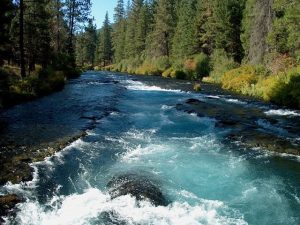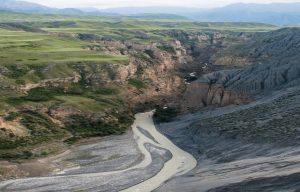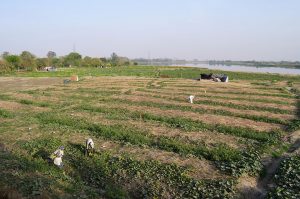As the Willamette River gushes through the pine-covered Willamette watershed, one cannot help but notice its hastiness and desire to do what it does best- reshaping the channel morphology and sustaining a plethora of aquatic life. This hastiness could probably be attributed to its desire to flow freely without human alterations before it suffers again the brunt of man, who has erected dams incessantly at different stages of the river to exploit its grandiose powers for hydroelectric power production and navigation. Even though these efforts by man seem plausible, one thing remains, dams result in an immense reduction of sediment downstream. This reduction if not properly monitored, may consequently have adverse effects on the well-being of the stream ecosystems.
Figure 1: The fast flowing waters of the Willamette River in Lane County, Oregon.
Sediments play an invaluable role of creating diverse ecological habitats. Invertebrates and other micro-organisms rely on the simple habitats engineered by the river currents as the river deposits load and creates new pathways. These habitats support a community of organisms that depend on each other in magnificently interlinked foodwebs, while the river acts as a regulating agent determining the relocation and emergence of new habitats as it erodes bank channels and deposits sediment in different sections. This ensures redistribution of organisms along the river channel thus promoting biological diversity. It is this biological diversity that grants communities formidable strength to withstand perturbations such adverse weather changes by enhancing community succession and colonization of new habitats. However, with reduced sediment amounts due to damming, intermittent biotic populations along river channels are inevitable. These erratic populations if not properly monitored may become extinct. For instance, sensitive micro-invertebrates and migrating birds that rely on such habitats for spawning or foraging may experience a population bottleneck or forced emigration that leads to population outbursts in other ecosystems while leaving unfilled ecological niches in the previous habitats. The ultimate effect is the loss of ecological diversity and species succession, all attributable to damming of hydrologic systems.
Moreover, reduction of sediment downstream has resulted in compromised water table levels. This is because with reduced sediment in a river’s current, the velocity of the river augments. This can be detrimental to the channel morphology as the river uses its grinding powers to make deep incisions into its river bed and causes massive erosion of its banks. The result is a reduction of the subsurface water levels as water percolates deep into 
Figure 2: Increased stream velocities cause massive downcutting of their riverbeds leading to lowering of streams and consequently the watertable.
the underground aquifer. Aquatic animals and other riparian vegetation now suffer the brunt of a hydrologic drought. Survival for the fittest demands that aquatic organisms have to either move upstream to escape the adverse effects of the hydrologic drought downstream or die from intraspecific competition for the limited resources with other aquatic animals. On the other hand, the initially water-logged soils of the riparian zone now become dry soils that allow free movement of air between their crevices. Nitrogen is able to accumulate in these soils and is released into water channels when the water table rises during events such as floods or hurricanes. This deposition of nitrogen into water sources has the effect of increasing algal blooms and ultimately causing eutrophication. Likewise, with reduced water levels comes reduced riparian vegetation cover. A huge portion of the invaluable function played by riparian zones as buffer systems is lost and streams become exposed to the raging effects of pollution from nearby ecosystems. This is double tragedy to aquatic life that now have to show forbearance towards the scarce water burden due to diminishing water table levels, and imminent threats from pollution. In the long-term, adverse ecological problems are inevitable.
Evidently, floodplains rely heavily on sediments carried downstream by rivers. These sediments are the veins of floodplains, as they are responsible for the fertile soils that make floodplains agriculturally viable regions rather than pools of waterborne infections such as Bilharzia. Native Americans that lived along the coastal plains of the James River particularly relied on the rich soils of the tidewater region to grow subsistence crops such as corn and beans. These coastal plains produced substantial amounts of food that enabled trade within the Native American tribes. Similarly, today many countries rely on floodplains for food production. These extensive tracts of floodplains play a critical role of
Figure 3: Farming on the Yamuna River floodplains in Delhi.
curbing food insecurity and providing an impetus for economic growth. Moreover, floodplains have proven to be invaluable water filters. Studies show that when floodplains get inundated with water, they act as natural filters that remove excess sediment and nutrients from the water before it enters other hydrologic systems. This is significant to the health of aquatic animals and human beings that draw water from such systems. Degradation of water quality has particularly been observed along small rivers and at hypoxic regions of large rivers due to loss of floodplain habitat. This loss thus allows excessive nutrients to enter hydrologic systems. Damming consistently reduces the amount of sediments reaching the coastal plains thus massively contributing to the exacerbation of this water quality issue. Ultimately, flood plains that once served the invaluable functions mentioned above become ineffectual areas of no ecological or human significance.
It is eminent that dams cause appalling effects to ecological and hydrologic systems in the long-term. These effects lead to loss of ecological diversity and degradation of land and other water resources. These effects may take time before they are discernible to us because the rather ephemeral benefits we derive from damming such as hydroelectric power production, enhanced navigation and recreation blind us from foreseeing the ultimate ecological impacts of our actions. Unfortunately, the end result is a loss both to man and ecosystems subservient to him.
References:
http://www.nature.org/ourinitiatives/habitats/riverslakes/benefits-of-healthy-floodplains.xml
https://www.google.com/searchq=reduced+water+tables&espv=2&biw=1366&bih=613&source=lnms&tbm=isch&sa=X&ved=0ahUKEwjtzoSNiNPPAhVJcD4KHRWmBFAQ_AUIBygC#tbm=isch&q=river+incision+&imgrc=vUQzX_y3q0DY7M%3A
https://www.google.com/search?q=floodplain+on+yamuna+river&espv=2&biw=1366&bih=662&source=lnms&tbm=isch&sa=X&ved=0ahUKEwjfz6H_yN_PAhWIoD4KHZ_rDDIQ_AUIBigB#tbm=isch&q=yamuna+floodplains&imgrc=dMynlil-XXOmVM%3A

